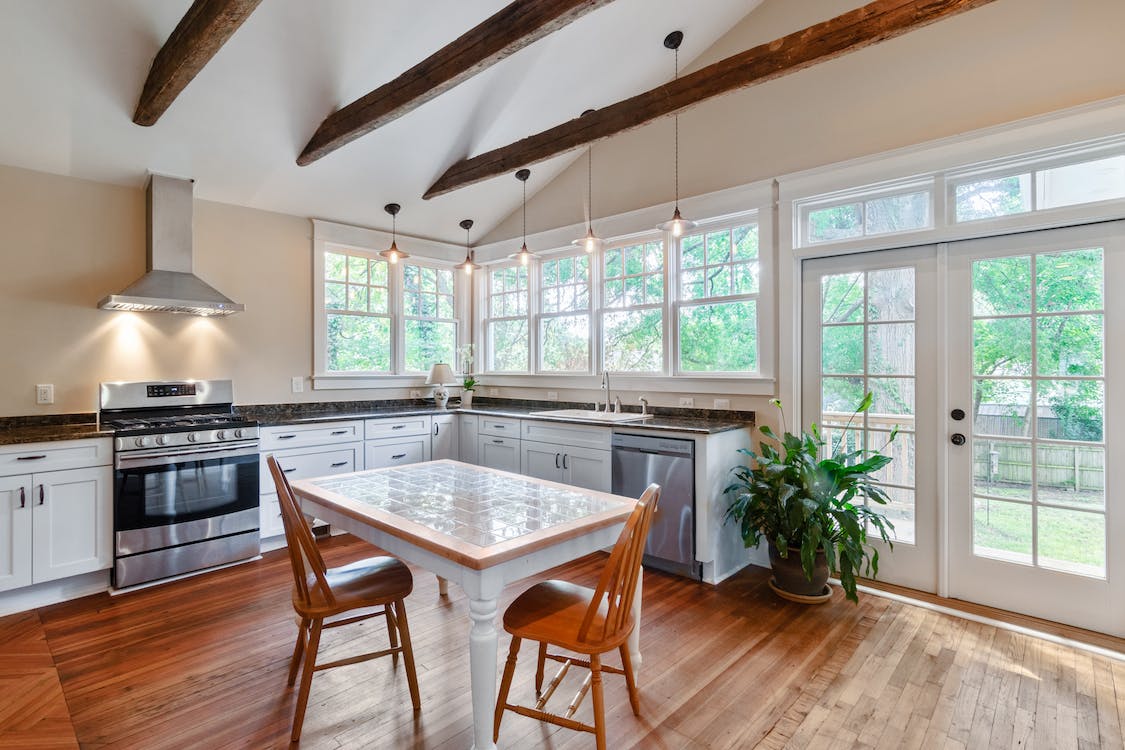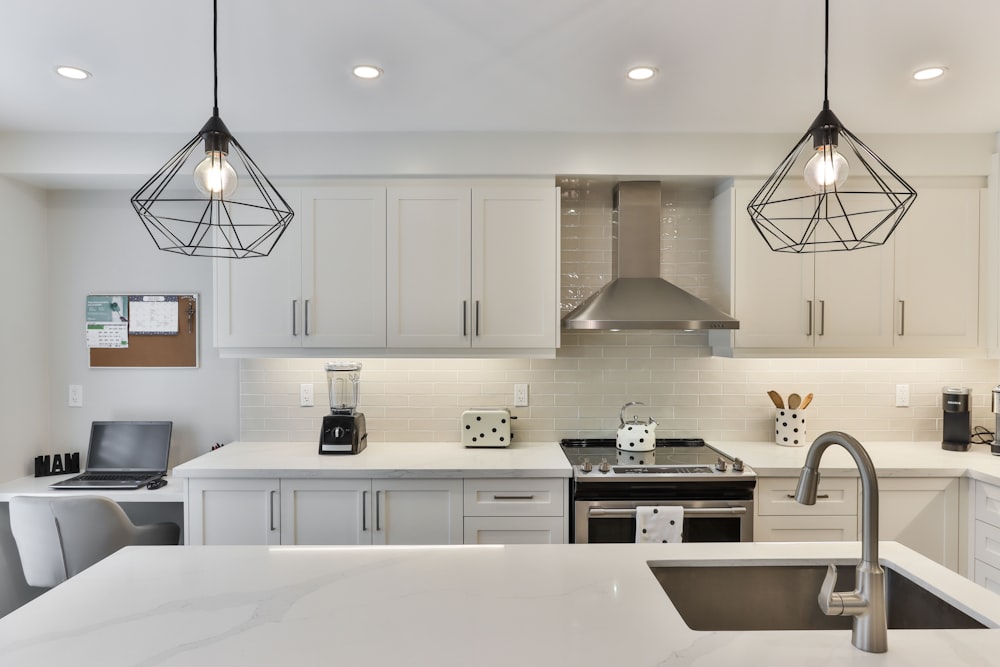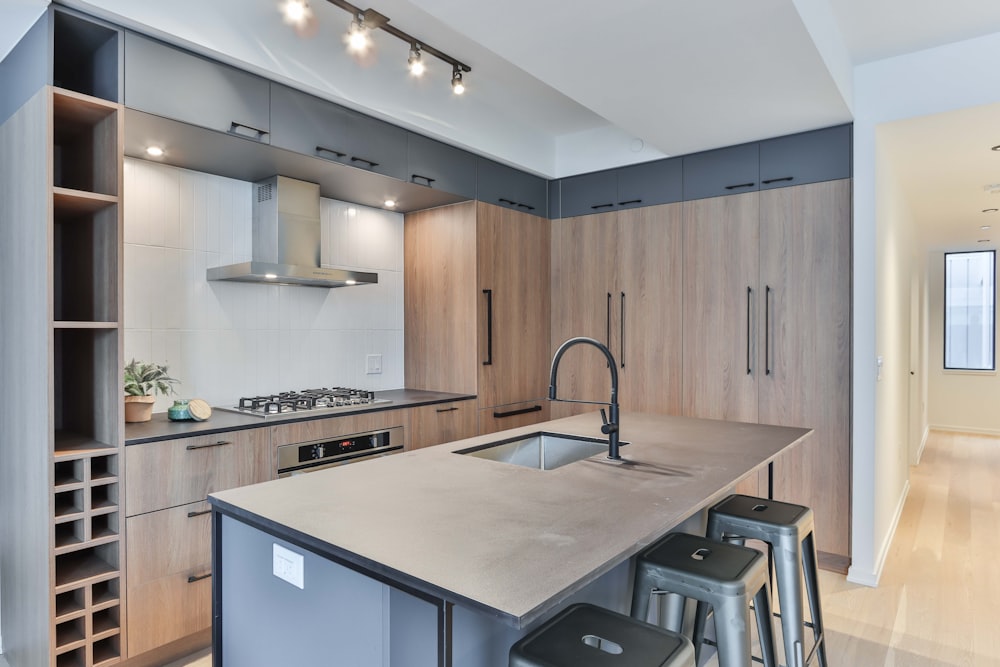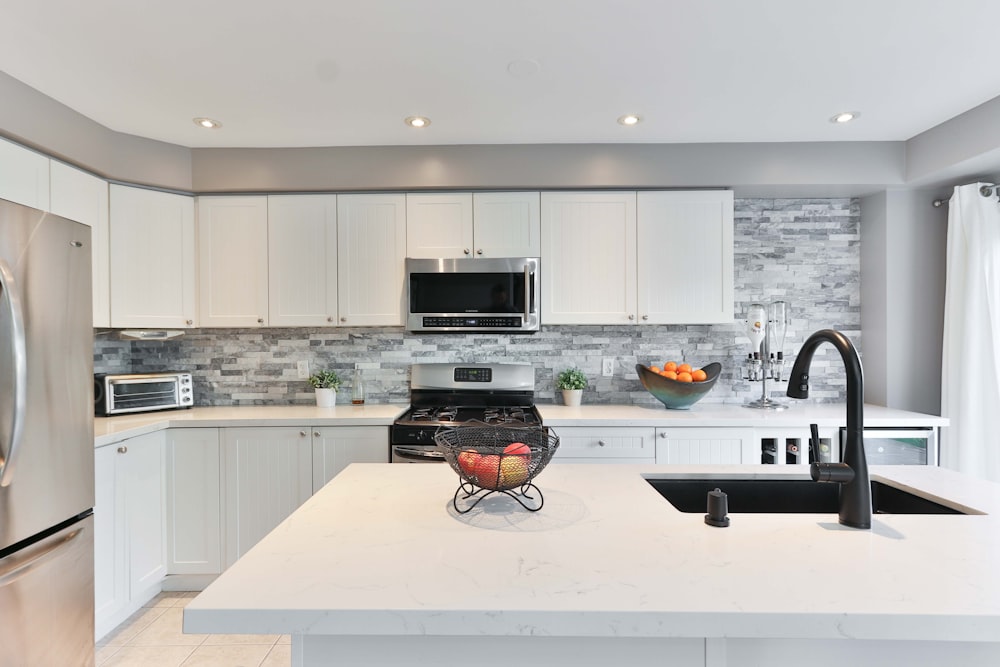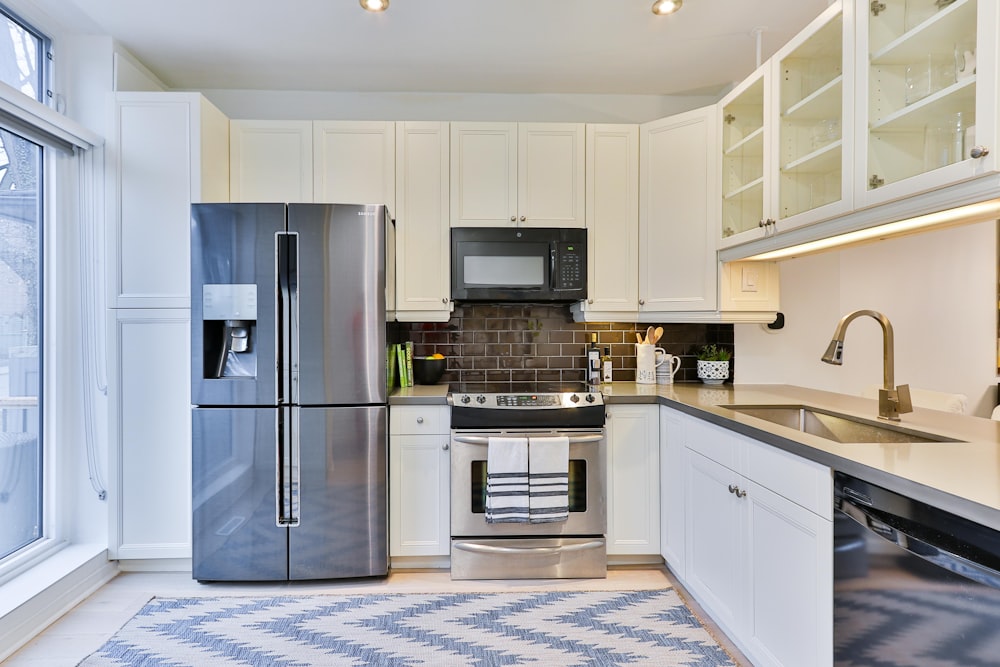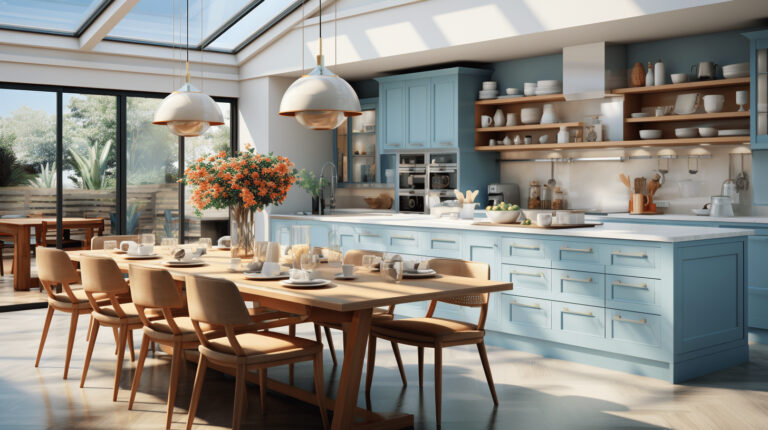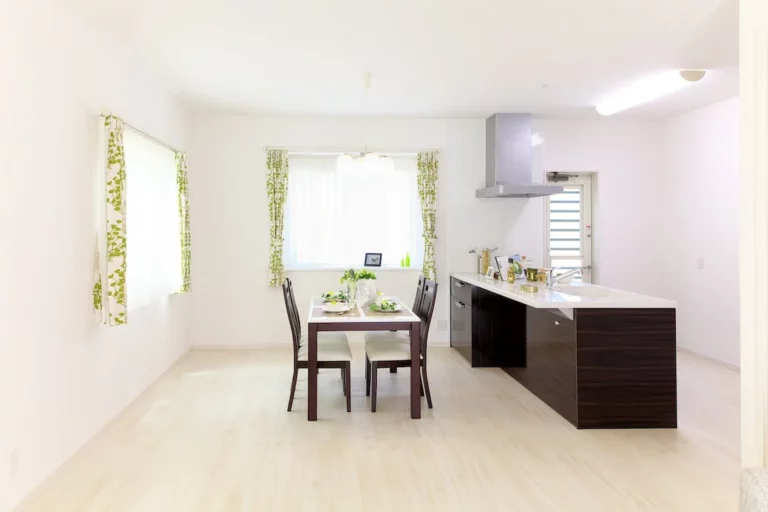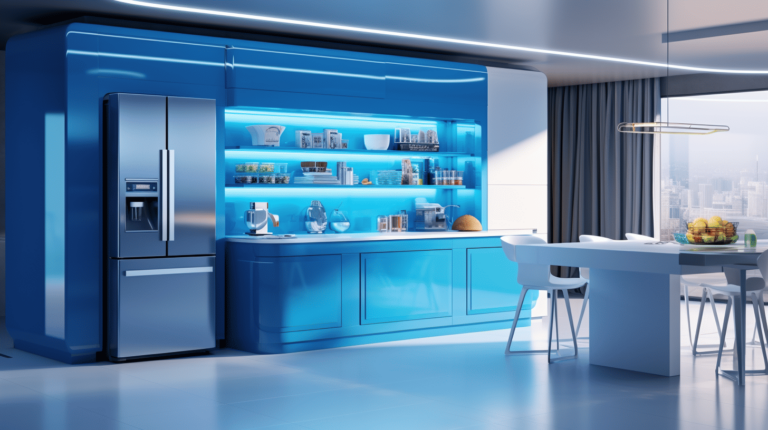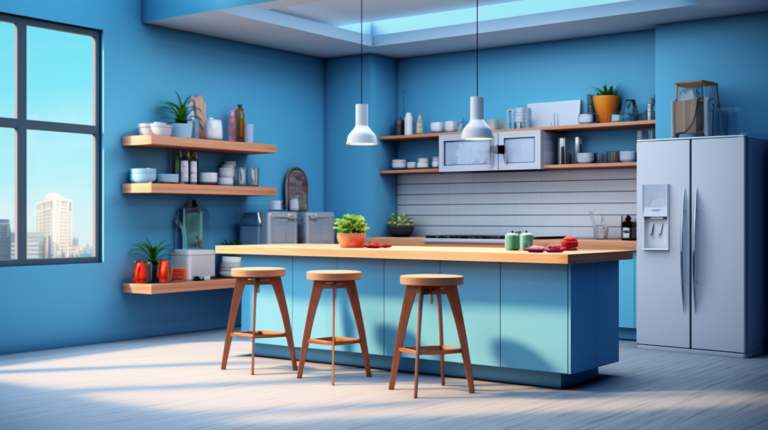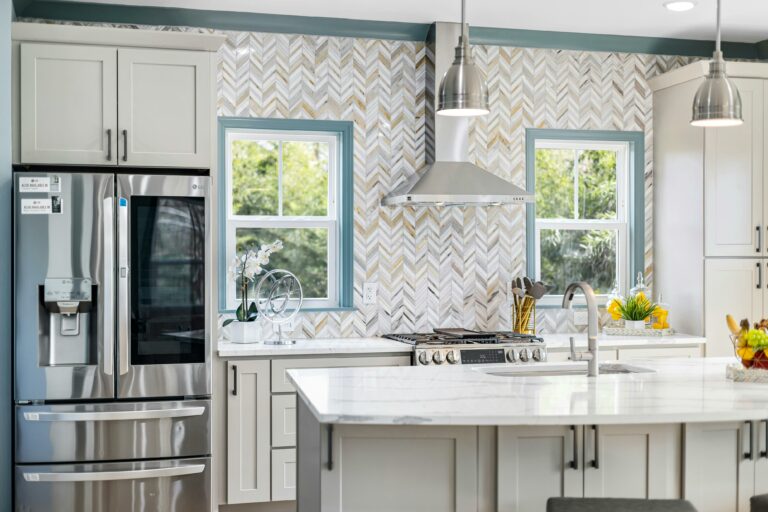Designing a Minimalist Kitchen : Streamlined Ideas for a Clutter-Free Space in 2024
Welcome to the world of minimalist kitchen design! In this article “Designing a Minimalist Kitchen : Streamlined Ideas for a Clutter-Free Space in 2024”, we will explore the concept of designing a clutter-free and streamlined kitchen. If you’re tired of a kitchen filled with unnecessary items and are looking to create a space that is both functional and aesthetically pleasing, then this article is for you.
Table of Contents
Designing a Minimalist Kitchen
A minimalist kitchen focuses on simplicity and functionality, with an emphasis on clean lines and open spaces. It is a design trend that has been growing in popularity and shows no signs of slowing down. By following the principles of minimalist design, you can transform your kitchen into a serene and organized space that not only looks beautiful but also enhances your cooking experience.
In the following sections, we will discuss the current trends in minimalist kitchen design, the key features that define this style, and practical strategies for organizing and maintaining a minimalist kitchen. So, let’s dive in and discover how you can achieve a clutter-free and streamlined kitchen that combines style and functionality.
Trends in Minimalist Kitchen Design
Minimalist kitchens have become increasingly popular in recent years, and this trend shows no signs of slowing down. People are drawn to the clean and streamlined aesthetic that a minimalist kitchen offers. By focusing on simplicity and functionality, these kitchens create a clutter-free space that is both visually appealing and practical. Here are some trends that are shaping the design of minimalist kitchens:
Popularity and Forecast
- Minimalist kitchens are gaining popularity and this trend is expected to continue rising.
- People are embracing the idea of living with less and opting for a more minimalist lifestyle.
- The concept of minimalism extends beyond just design and has become a way of life for many.
Major Features
- Clean lines: Minimalist kitchens are characterized by clean and simple lines that create a sense of calm and order.
- Open shelving: Instead of traditional upper cabinets, open shelving is becoming a popular choice in minimalist kitchens. It adds a sense of airiness and allows for easy access to everyday items.
- Glass cabinets: Glass cabinets are another feature commonly seen in minimalist kitchens. They add a touch of elegance and allow for display of beautiful dishes or decorative pieces.
- Neutral color palettes: Minimalist kitchens often stick to neutral color palettes, such as whites, grays, and natural wood tones. These colors create a serene and timeless look.
- Natural materials: From countertops to flooring, natural materials such as wood, stone, and concrete are being used in minimalist kitchens. These materials add warmth and texture to the space.
- Concealed storage: With a minimalist approach, it’s important to have ample storage to keep the countertops clutter-free. Concealed storage solutions, such as pull-out drawers and hidden appliances, are key features in these kitchens.
- Designated spots: Everything in a minimalist kitchen has its designated spot. From utensils to spices, having a specific place for everything reduces visual clutter and makes it easier to find what you need.
- Vertical storage: Maximizing vertical space is crucial in a minimalist kitchen. This can be achieved through the use of tall cabinets or hanging pot racks, which help keep the countertops clear.
Minimalist kitchens are all about function and simplicity. By incorporating these trends into your kitchen design, you can create a space that is both stylish and practical.
Functionality of a Minimalist Kitchen
When designing a minimalist kitchen, functionality is a key aspect to consider. A minimalist kitchen is all about simplicity and efficiency, creating a space that is streamlined and clutter-free. Here are some key points to understand about the functionality of a minimalist kitchen:
Simplicity Focus
The main focus of a minimalist kitchen is simplicity. This means eliminating unnecessary items and keeping only the essentials. By reducing clutter and excess decoration, you create a clean and serene environment that is easy to navigate and use.
Functionality Emphasis
In a minimalist kitchen, functionality is prioritized over aesthetics. This means that every element in the kitchen should serve a purpose and contribute to the overall efficiency of the space. Consider the layout, storage options, and appliances to ensure that they are practical and make your cooking and meal preparation tasks easier.
Here are a few tips to achieve functionality in a minimalist kitchen:
- Optimize Layout: Choose a layout that allows for easy movement and accessibility to different areas of the kitchen. The “work triangle” concept, which emphasizes the flow between the sink, stove, and refrigerator, is a popular choice for efficient kitchen layouts.
- Maximize Storage: Utilize clever storage solutions that make the most of your kitchen space. This includes installing cabinets with pull-out shelves, utilizing vertical storage options such as tall cabinets or open shelving, and incorporating multifunctional furniture pieces like kitchen islands with built-in storage.
- Choose Efficient Appliances: Invest in energy-efficient and space-saving appliances. Look for appliances with smaller footprints that still offer the necessary functionality. This will help you save space and energy in your minimalist kitchen.
- Keep Countertops Clear: Clear and uncluttered countertops are essential in a minimalist kitchen. Limit your countertop appliances and accessories to only those that you use frequently. Store other items in cabinets or drawers to maintain a clean and organized workspace.
By focusing on simplicity and functionality, you can create a minimalist kitchen that not only looks sleek and modern but also enhances your cooking experience. Remember, a clutter-free and efficient kitchen will not only save you time but also make your daily routines more enjoyable.
Features of a Minimalist Kitchen
When it comes to designing a minimalist kitchen, there are several key features that can help create a clutter-free and streamlined space. These features not only enhance the aesthetics of the kitchen but also promote functionality and ease of use. Let’s explore some of the main features of a minimalist kitchen:
- Clean Lines: Minimalist kitchens often embrace simple and clean lines. This means avoiding ornate details and opting for sleek and uncomplicated designs. Clean lines help create a sense of order and calmness in the space.
- Open Shelving: Open shelving is a popular feature in minimalist kitchens. It replaces traditional upper cabinets with open shelves, allowing for a more open and airy feel. This also encourages homeowners to keep only essential items on display, reducing clutter.
- Glass Cabinets: Another way to achieve a minimalist look is by incorporating glass cabinets. Glass not only adds an element of elegance but also creates a sense of visual lightness. It allows you to showcase your beautiful dinnerware and keeps everything within reach.
- Neutral Color Palettes: Minimalist kitchens often feature neutral color palettes, such as shades of white, beige, and gray. These colors help create a clean and calm atmosphere. They also provide a versatile backdrop, making it easier to add pops of color through accessories or artwork.
- Natural Materials: Incorporating natural materials, such as wood and stone, can add warmth and texture to a minimalist kitchen. Opt for natural wood cabinets or a stone countertop to bring in a touch of nature. These materials also have a timeless appeal, ensuring your kitchen will look stylish for years to come.
- Concealed Storage: In minimalist kitchens, storage is key. To maintain a clutter-free space, consider incorporating concealed storage solutions. This can include pull-out drawers, hidden cabinets, and integrated appliances. Concealed storage helps keep countertops clear and maintains a streamlined appearance.
- Designated Spots: A minimalist kitchen thrives on organization. Designate specific spots for each item, whether it’s for your coffee mugs, utensils, or cutting boards. This ensures that everything has its place and reduces the chances of clutter accumulating on countertops.
- Vertical Storage: Make the most of your kitchen’s vertical space by utilizing wall-mounted storage solutions. This can include open shelving, hanging racks, or magnetic strips for knives. Vertical storage not only maximizes space but also adds visual interest to the kitchen.
Incorporating these features into your kitchen design will help you achieve a minimalist look that is both stylish and functional. Remember, the aim is to create a clean and clutter-free space that promotes ease of use and a sense of calm. So, embrace simplicity and let your kitchen shine with its minimalist charm.
Also Read: The Dos and Don’ts of Kitchen Renovations.
Organizational Strategies for a Minimalist Kitchen
When it comes to creating a minimalist kitchen, organization is key. A clutter-free space not only looks pleasing to the eye but also makes cooking and meal preparation a breeze. Here are some effective organizational strategies to help you maintain order and simplicity in your minimalist kitchen:
Using Trays and Dividers
One of the most effective ways to keep your kitchen organized is by using trays and dividers. These simple tools can help divide and separate items in your drawers and cabinets, making it easier to find what you need when you need it. Here are some ideas for using trays and dividers in your minimalist kitchen:
- Drawer Dividers: Use drawer dividers to separate utensils, silverware, and other small kitchen tools. This not only keeps everything neat and organized but also prevents items from rolling around or getting tangled up.
- Stackable Trays: Stackable trays are perfect for storing plates, bowls, or even cutting boards. They help save space and give your kitchen a clean, uncluttered look. Opt for clear trays to easily see what’s inside.
- Spice Jar Organizer: Keep your spices organized and easily accessible with a spice jar organizer. This handy tool allows you to store your spices in a compact and uniform manner, saving space and reducing visual clutter.
Decluttering Habits
In a minimalist kitchen, it’s important to regularly declutter and remove items that you no longer need or use. Here are some habits to help you maintain a clutter-free space:
- Purge Regularly: Set aside some time every few months to go through your kitchen items and get rid of anything you no longer use or need. This includes expired food items, duplicates, or kitchen gadgets that haven’t seen the light of day in years.
- Donate or Sell: Instead of throwing away items, consider donating them to a local charity or selling them online. Not only will you be decluttering your kitchen, but you’ll also be giving your unwanted items a second life.
- One In, One Out: Implement a “one in, one out” rule when it comes to adding new items to your kitchen. For every new utensil, appliance, or gadget you bring into your kitchen, make sure to remove one old or unused item. This helps prevent accumulation and maintains a minimalistic approach.
Remember, the key to an organized minimalist kitchen is to keep only the essentials and create designated spots for each item. By using trays and dividers and practicing decluttering habits, you can create a streamlined and functional kitchen that is a joy to work in.
“Simplicity is the ultimate sophistication.” – Leonardo da Vinci
Importance of Maintaining a Minimalist Space
Once you’ve successfully redesigned your kitchen to embrace a minimalist aesthetic, it’s essential to understand the importance of maintaining this clutter-free space. Maintaining a minimalist kitchen not only contributes to the overall visual appeal but also enhances the functionality and efficiency of the space. Here are a few reasons why maintaining a minimalist space is crucial:
Regular Clear-outs
Regularly clearing out your kitchen is essential to maintain a minimalist space. It’s easy for items to accumulate over time, including unnecessary appliances, utensils, and cookware. By conducting regular clear-outs, you can ensure that only essential items remain in your kitchen. This will help you maintain a clean and organized space and make it easier to find things when you need them. Consider the following tips for regular clear-outs:
- Set a schedule for decluttering your kitchen, such as every six months or at the change of seasons.
- Take a systematic approach by going through one area or category at a time, like cabinets or drawers.
- Evaluate each item and ask yourself if it is truly necessary or if it serves a specific purpose in your kitchen.
- Donate or sell items that are in good condition but no longer needed.
- Dispose of any broken or unusable items responsibly.
Specific Homes for Belongings
Maintaining a minimalist kitchen involves ensuring that every item has a designated spot. When everything has a specific place to be stored, it becomes easier to keep the kitchen organized, and you’ll always know where to find what you need. Here are a few tips for assigning specific homes for your belongings:
- Group similar items together, such as pots and pans in one cabinet and spices in another.
- Use dividers and trays in drawers to keep utensils, cutlery, and other small items organized.
- Consider incorporating labeled storage containers for items like baking ingredients or bulk pantry items.
- Opt for storage solutions that maximize space and keep items easily accessible, such as pull-out shelves or vertical storage units.
By maintaining specific homes for your belongings, you’ll not only keep your kitchen organized but also prevent unnecessary clutter from accumulating. Plus, it will make cooking and food preparation more efficient and enjoyable.
Remember, the key to maintaining a minimalist space is consistency. Make it a habit to regularly clear out and reorganize your kitchen to prevent clutter from creeping back in. By doing so, you’ll continue to enjoy the benefits of a streamlined and clutter-free space.
“The more you let go, the higher you rise.” – Ralph Waldo Emerson
Also Read: The Top Kitchen Flooring Options for Durability and Style in 2024.
Conclusion
In conclusion, designing a minimalist kitchen can bring a sense of calm and organization to your space. By focusing on simplicity, functionality, and incorporating key features such as clean lines, open shelving, and neutral color palettes, you can create a clutter-free and visually appealing kitchen.
Remember to implement organizational strategies like using trays and dividers, and develop decluttering habits to maintain a minimalist space. Regular clear-outs and assigning specific homes for belongings will help you stay organized and prevent clutter from accumulating.
By embracing a minimalist approach to kitchen design, you can create a space that not only looks visually pleasing but also provides a functional and efficient environment for your everyday cooking and gathering needs.
For more kitchen design inspiration and ideas, visit Minimalist Kitchen Design in 2024 : Streamlined Cooking Space. Explore our blog and take your first step towards creating your dream minimalist kitchen.
Frequently Asked Questions
- What is a minimalist kitchen design?
A minimalist kitchen design is a concept that focuses on simplicity, functionality, and the elimination of excess clutter. It often features clean lines, a neutral color palette, and efficient storage solutions. - Why should I consider a minimalist kitchen design?
A minimalist kitchen design offers several benefits. It creates a calming and organized space, improves functionality and efficiency, reduces visual clutter, and promotes a sense of serenity and mindfulness in the kitchen. - What are some key elements of a minimalist kitchen design?
Some key elements of a minimalist kitchen design include decluttering countertops, utilizing open shelving or hidden storage solutions, opting for simple and sleek cabinetry, choosing a neutral color palette, and incorporating natural light. - How can I achieve a clutter-free minimalist kitchen?
To achieve a clutter-free minimalist kitchen, start by decluttering and organizing your kitchen items. Store only the essentials and get rid of items that are rarely used. Maximize storage space, keep countertops clear, and adopt a ‘less is more’ approach when it comes to decor. - Are there any specific materials or finishes that work well in a minimalist kitchen?
Materials such as stainless steel, glass, concrete, and natural wood often work well in a minimalist kitchen. Opt for sleek and durable finishes that are easy to clean and maintain, contributing to the overall minimalist aesthetic.

